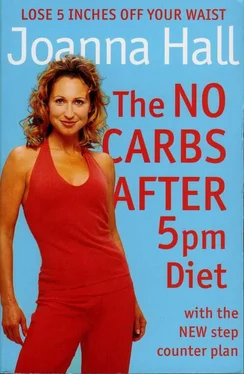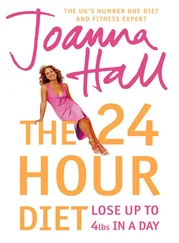If you and your partner are doing the diet together, and you have children, you may find it harder to get the walking done in the evenings, especially if the children are too young to be left on their own. In this instance it may be more practical to have a buddy for your eating principles (such as your partner/husband) and another buddy for your exercise principles. And remember to get your children involved – let them be your walking buddies at the weekends, and allow them to fill in your charts and step targets. This can be a real motivator, and you are giving them a fantastic health message about looking after their own bodies too.
So if you are ready let’s …
Plan ahead
Be prepared
 Become empowered
Become empowered
CLIENT FEEDBACK: ZITA
I have worked in the music industry for 17 years, running my own company managing producers, songwriters and artists. My job is very full-on. I have three children aged ten, eight and five. I also had a child adopted, who would now be 20. So, having had lots of babies, my stomach and navel area has always been the most problematic. After the first baby the weight just disappeared within weeks, but I piled on weight after each of the others. I gained four stone and looked like a womble!
When I went to have my annual medical recently, I found I had put on a stone without realizing it. My body fat was too high at 34 per cent, and my cholesterol was high as well. My doctor recommended Joanna’s programme. He had followed it himself, lost over a stone and felt so much better. I have bad habits and drive everywhere. I’ve gone through phases of personal training but have never managed to exercise on my own before – until now.
I found the first week really hard. But once the endorphins start to kick in because of the walking and tummy exercises, I think that starts to make it easier. I just knew I was not going to stop after the first week.
I am a huge fan of Joanna’s 28-day plan. I can’t call it a diet – it really is a lifestyle change. I think that makes it easier in a way, as there’s no beginning and end, just an ongoing programme. The Carb Curfew has kept my weight and inch loss constant. When I first started the programme, I really craved carbs in the evening. Now if I do eat carbs in the evenings, at other people’s houses or at restaurants, I feel full very quickly, and often a little uncomfortable. I used to feel very heavy and tired after eating. I now feel light and have more energy. I love salads and have always enjoyed meat or fish and vegetables. The best thing is that if I stick to this I can still have my naughty treats during the day like crisps, a few squares of chocolate and an occasional slice of cake.
The exercising and the clear, easy-to-follow plan definitely affected my inch loss. I lost 6kg and 5 per cent body fat. My cholesterol went down from 6.75 to 5.5 in nine weeks, which was great.
Even with my busy lifestyle as a mum of three, running my own company, going out a lot and entertaining a fair bit, I have still managed to keep most of the weight off.
2 Recording Your Progress
CALCULATING YOUR BODY MASS INDEX
Recording your measurements is an important part of tracking your progress. Calculating your body mass index (BMI) will enable you to determine how much weight you need to lose. To calculate your BMI, divide your weight in kilograms by your height in metres squared. You’ll find an automatic BMI calculator on my website, www.joannahall.com
 If your BMI is between 25 and 29, you are overweight.
If your BMI is between 25 and 29, you are overweight.
If your BMI is between 30 and 39, you are obese.
 If your BMI is 40 or above, you are morbidly obese.
If your BMI is 40 or above, you are morbidly obese.
WHAT YOUR WAIST MEASUREMENT REVEALS
While BMI is widely recognized as a measure of obesity, it does not give a strong indication of your health risks. Storing your weight around your waist or midriff is known as ‘abdominal obesity’. This measurement is much more closely related to your risks of developing chronic disease than your BMI value alone. So, on this diet, the number you need to know and are specifically going to track is your waist circumference.
Metabolic syndrome is the term for a cluster of disorders that place you at increased risk of chronic disease. Your waist measurement is one of the strongest indicators of whether you are prone to metabolic syndrome and its associated disorders. These disorders include:
 Excess levels of triglycerides (‘bad’ blood fats)
Excess levels of triglycerides (‘bad’ blood fats)
Decreased values of high-density lipoproteins (‘good’ blood fats)
 High blood pressure
High blood pressure
A high fasting blood glucose value
 Increased insulin resistance
Increased insulin resistance
Waist measurements indicating risk of disease are different for men and women:
Men with a waist measurement greater than 102cm (40 inches) are at risk.
Women with a waist measurement greater than 88cm (35 inches) are at risk.
Please note: if a person has a short stature (under 5 feet in height) and a BMI of 35 or above, waist circumference standards may not apply. If this applies to you, ask your GP to assess your risk of metabolic syndrome.
Quite simply, the medical conditions that worsen with weight gain will improve with weight loss:
High blood pressure
 Dyslipidaemia (adverse blood fats)
Dyslipidaemia (adverse blood fats)
Sleep apnoea
Infertility
 Cardiovascular disease
Cardiovascular disease
 Type 2 diabetes
Type 2 diabetes
Osteoarthritis
“The motivation kicks in as soon as you start to see the results and realize you can maintain them. I felt results within four days. Also, quite early on, my skin felt better and people were saying I looked so much healthier.”
Читать дальше

 Become empowered
Become empowered










